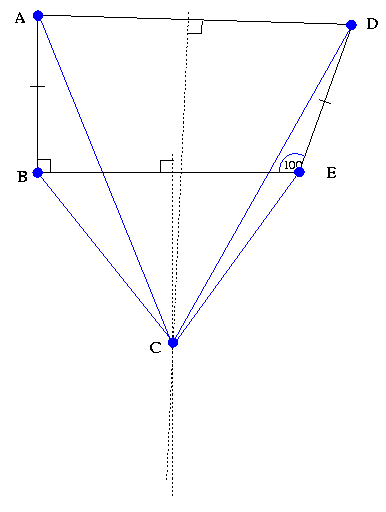Proof that 90=100
 We construct a 4-sided figure ABED as follows:
We construct a 4-sided figure ABED as follows:
|∠ABE| = 90 degrees |∠BED| = 100 degrees |AB| = |ED|Once we have that, we'll now tinker a bit to show that 90=100: Draw the perpendicular bisectors to BE and AD; they'll meet at some point we'll name C. Note that while the figure is indeed not necessarily to scale, this argument stays the same whether C is below BD, or above it, on BD. (You should verify this later.) (Lemma: we must prove that those two lines indeed meet (i.e. that the point C even exists); wouldn't be too hard to do this, since it's pretty clear that AD and BE aren't parallel.)
1. |AB| = |ED| by construction 2. |BC| = |EC| C on perp.bisector of AE (thus triangle BEC is isosceles) 3. ∠CBE ≈ ∠BEC base angles of isosocles triangle BEC are congruent 4. |∠CBE| = |∠BEC| congruent angles have equal measures, and line3 5. |AC| = |DC| C on perp.bisector of AE 6. ABC ≈ DEC (!!) by SSS, and lines 1,2,5.From here, it's just routine steps to conclude 90=100:
7. ∠ABC ≈ ∠DEC corresponding parts of corresponding triangles; 6 8. |∠ABC| = |∠DEC| congruent angles have equal measures; line 7 9. |∠ABC| = |∠ABE| + |∠CBE| by construction 10. |∠DEC| = |∠DEB| + |∠BEC| by construction 11. |∠DEC| = |∠DEB| + |∠CBE| subst. equals for equals; lines 10 and 4 12. |∠ABC| = |∠DEB| + |∠CBE| subst. equals for equals; lines 11 and 8 13. |∠ABE| + |∠CBE| = |∠DEB| + |∠CBE| subst. equals for equals; lines 12 and 9 14. |∠ABE| = |∠CBE| subtract equals from equals remains equal 15. 90 = |∠CBE| by construction, and replace-equals-by-equals 16. 90 = 100 by construction, and replace-equals-by-equals
A useful corollary: 0=1.
1. 90 = 100 Previous theorem. 2. 0 = 10 Subtract 90 from both sides remains equal 3. 0 = 1 Divide by 10 (non-zero) on both sides remains equal.
Note that were C to occur above BE, then the proof is essentially the same; we just change lines 9 and 10 to have a - instead of a +, and on line 13 we add (rather than subtract) the same to both sides. (If C occured exactly on BE, then either proof would hold, as we'd be adding or subtracting zero.)
Challenge:
Identify exactly, which is the first line in error.
(If you can't, you are welcome to give me $100,
and i'll return you an equal amount. :-)
This result suggests we need to be good at proofs.